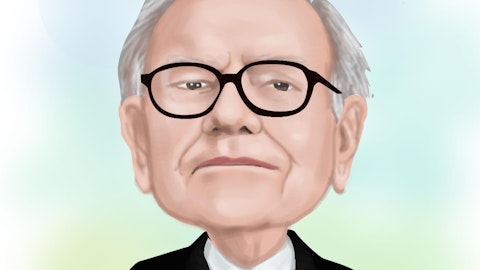Andrew Young: Got it. Yeah, sorry, I didn’t quite follow the second half of it. That was what I was trying to explain in my answer is, the net of all of that ultimately ends up being a wash, the part where we will be holding more capital on the denominator side, strictly for the risk-weighting assets again, I should highlight that it’s in a comment period, a lot of industry focus on it and well, particularly as it relates to the opt risk calculation, there could be material impacts on the final outcome relative to what’s proposed. But taking what is currently proposed, the asset side specifically outside of the operational risk ends up being roughly a draw for us, and it’s really just the operational risk that’s going to require us to hold more capital.
Jeff Norris: Dominick, you have a follow-up? Next question, please.
Operator: Our next question comes from Bill Carcache with Wolfe Research. Your line is open.
Jeff Norris: You there Bill.
Bill Carcache: Can you hear me?
Richard Fairbank: Yeah.
Bill Carcache: Okay. Great. Thank you. Yeah. So I wanted to ask about the leaf fee proposal. The consensus view is that we’ll get it very soon. It will be immediately litigated. Can you give us your view on the likely path that you would anticipate and possibly speak to any potential costs that might be associated with it?
Richard Fairbank: Okay. Thank you, Bill. So the CFPB’s late fee proposal as currently contemplated would reduce late fees by approximately 75%. And while the CFPB’s proposal has not yet been finalized, we expect the CFPB to publish a proposal soon, probably before the end of the year. Now once the CFPB publishes its final rule, we expect there to be industry litigation that could delay or block the implementation of this rule. And this litigation will likely delay the implementation of the rule until at least the second half of 2024 and maybe longer. If the proposed rule is implemented, there will be a significant impact to our P&L in the near term. However, we have a set of mitigating actions that we’re working through that we believe will gradually resolve this impact a couple of years after the rule goes into effect.
These choices include changes to our policies, products and investment choices. Some of these actions will take place before the rule change takes effect many will come after the rule change takes effect.
Jeff Norris: Next question, please.
Operator: One moment please. Our final question is a follow-up from Dominick Gabriele with Oppenheimer. Your line is open.
Dominick Gabriele: Hey. Sorry about that. I think I got cut off. Can you hear me okay?
Richard Fairbank: Yes, we can Dominick.
Dominick Gabriele: All right. Sorry about that, guys. I was actually just curious on the quarter-over-quarter increase in domestic card yield. I know that there’s sometimes some seasonality in the third quarter, and we’ve also had a lot of rate hikes in previous years around the third quarter. I was wondering if you could just walk us through some of the dynamics in the quarter-over-quarter increase in domestic card? Thanks so much.
Andrew Young: Yeah, Dominick. I can’t remember who asked it earlier, but just reiterating some of those points, I think you largely answered your own question, which is there is seasonality that in part is — or is a function of the revolve rates driven by some of the dynamics, Rich talked about over the course of the year, we did see the Fed move. And then we also saw a bit of late fees, which I would lump into the seasonality dimension. And then finally, we had one more day in the third quarter, so day count in an absolute sense, not necessarily relative to peers, which I think was the nature of the question earlier, but at least in an absolute sense. Those are the big drivers of what drove the quarter-over-quarter yield.
Jeff Norris: Well, thanks, everybody for joining us on the conference call this evening, and thank you for your continuing interest in Capital One. Investor Relations team will be here later this evening to answer any questions that you may have. Have a great evening, everyone.
Operator: This concludes today’s conference call. Thank you for participating. You may now disconnect.
Follow Capital One Financial Corp (NYSE:COF)
Follow Capital One Financial Corp (NYSE:COF)
Receive real-time insider trading and news alerts





